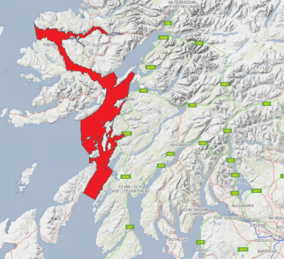Loch Sunart to the Sound of Jura Marine Protected Area facts for kids
Quick facts for kids Loch Sunart to the Sound of Jura MPA |
|
|---|---|
|
IUCN Category IV (Habitat/Species Management Area)
|
|
 |
|
| Location | Lochaber, Scotland |
| Area | 74,100 ha (286 sq mi) |
| Designation | Scottish Government |
| Established | 2014 |
| Operator | Marine Scotland |
The Loch Sunart to the Sound of Jura Marine Protected Area (MPA) is a special ocean area off the west coast of Scotland. It was created to protect important sea creatures and unique underwater landscapes. This MPA covers a huge area of about 741 square kilometers (286 square miles).
It includes the waters of Loch Sunart, the Sound of Mull, the Firth of Lorne, and the Sound of Jura. This area is very important for a special type of fish called the common skate. It also protects very old geological features found on the seabed.
Contents
What is a Marine Protected Area?
A Marine Protected Area (MPA) is like a national park, but for the ocean. These areas are set aside to protect marine life and habitats. They help keep our oceans healthy for future generations.
MPAs are important because they:
- Protect rare or endangered species.
- Keep important habitats safe.
- Help fish populations grow stronger.
- Allow scientists to study ocean ecosystems.
The Loch Sunart to the Sound of Jura MPA is a Category IV protected area. This means it is managed to protect specific habitats and species. The International Union for Conservation of Nature (IUCN) helps classify these areas worldwide.
Protecting Ocean Life
This particular MPA was created in 2014. Its main goal is to protect two very important things. One is a large fish called the common skate. The other is the amazing geological features on the seafloor.
The Amazing Common Skate
The common skate is one of the largest skate species in the world. It can grow up to 2.5 meters (8 feet) long. These flat, diamond-shaped fish live on the seabed. They use their wide fins to glide through the water.
Sadly, common skate populations have declined a lot. This is due to overfishing in the past. Protecting areas like this MPA helps them recover. It gives them a safe place to live and reproduce.
Ancient Rocks and Landscapes
The MPA also protects unique geological features. These are formations on the seabed that tell a story. They show how the Earth's surface changed over thousands of years. This includes changes from ice ages and other natural processes.
Studying these features helps scientists understand Earth's history. It also shows how the seabed was formed. This knowledge is important for understanding our planet.
Rules for Fishing
To protect the common skate and the seabed, certain fishing activities are controlled. These rules help make sure the area remains healthy. They prevent damage to the delicate underwater environment.
Some types of fishing are not allowed in this MPA. These include:
- Suction dredging: This uses powerful pumps to suck up material from the seabed.
- Mechanical dredging: This involves dragging heavy equipment along the seafloor.
- Beam trawling: This uses a large beam to hold open a net, which is dragged along the bottom.
- Demersal trawling: This is another method where nets are dragged along the seabed.
- Longline fishing: This uses a very long line with many baited hooks.
These methods can harm the seabed and catch non-target species. By restricting them, the MPA helps protect the common skate and its habitat. It allows the marine ecosystem to thrive.

